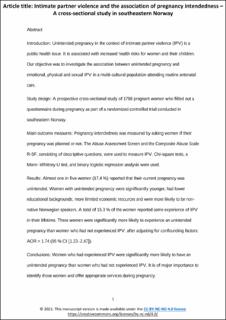Intimate partner violence and the association of pregnancy intendedness – A cross-sectional study in southeastern Norway
Flaathen, Eva Marie; Lukasse, Mirjam; Småstuen, Milada Cvancarova; Garnweidner-Holme, Lisa; Henriksen, Lena
Peer reviewed, Journal article
Accepted version
Permanent lenke
https://hdl.handle.net/11250/3017876Utgivelsesdato
2021-08-05Metadata
Vis full innførselSamlinger
Originalversjon
Sexual & Reproductive HealthCare. 2021, 29 . https://doi.org/10.1016/j.srhc.2021.100651Sammendrag
Objectives: Unintended pregnancy in the context of intimate partner violence (IPV) is a public health issue. It is associated with increased health risks for women and their children. Our objective was to investigate the as- sociation between unintended pregnancy and emotional, physical and sexual IPV in a multi-cultural population attending routine antenatal care. Study design: A prospective cross-sectional study of 1788 pregnant women who filled out a questionnaire during pregnancy as part of a randomized controlled trial conducted in southeastern Norway. Main outcome measures: Pregnancy intendedness was measured by asking women if their pregnancy was planned or not. The Abuse Assessment Screen and the Composite Abuse Scale R-SF, consisting of descriptive questions, were used to measure IPV. Chi-square tests, a Mann–Whitney U test, and binary logistic regression analysis were used. Results: Almost one in five women (17.4%) reported that their current pregnancy was unintended. Women with unintended pregnancy were significantly younger, had lower educational backgrounds, more limited economic resources and were more likely to be non-native Norwegian speakers. A total of 15.3% of the women reported some experience of IPV in their lifetime. These women were significantly more likely to experience an unin- tended pregnancy than women who had not experienced IPV, after adjusting for confounding factors: AOR = 1.74 (95% CI [1.23–2.47]). Conclusions: Women who had experienced IPV were significantly more likely to have an unintended pregnancy than women who had not experienced IPV. It is of major importance to identify those women and offer appropriate services during pregnancy.
